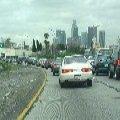Those who live in the United States have several options for getting where they would like to go.
Some of the larger cities in the US, such as New York City, Philadelphia, and Chicago, have light-rail systems similar to European cities.
Unfortunately, it is often difficult to use this as one's sole method of transportation. The rail system is usually not very large and serves mainly downtown business districts and tourist areas, with limited connections offered to the suburbs. This means that you have to live in town, which is usually more expensive. And, since not all jobs are downtown, you may live in town and still have to drive outside of the city to your job.
Another option is the bus. Because buses use the same roads as cars, a bus system has a lower cost than rail to implement and maintain. Even several medium-sized cities have bus systems. In some cities, suburbs have their own system that is separate from the one in the city, but includes a special route that will take you downtown, where you can then transfer to the bus system that operates within the city.
Although this interconnection has done much to increase the practicality of buses, there is still a cultural resistance to this mode of transportation.
The most common mode of transportation in the US is, by far, the car. Because American cities are not known for being compact (they are usually very spread out), this is often the most practical and efficient way to go. Unfortunately it also causes traffic problems, pollution, and a mounting anxiety over the need for oil used to make gasoline.
Cities will continue to experiment with transportation solutions. However, in suburbs and rural areas, which comprise most of the US, the car will continue to be king for a long time to come.

